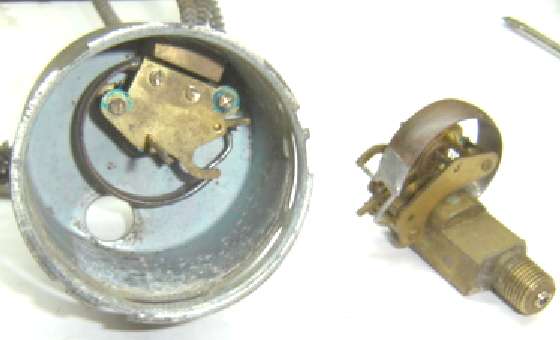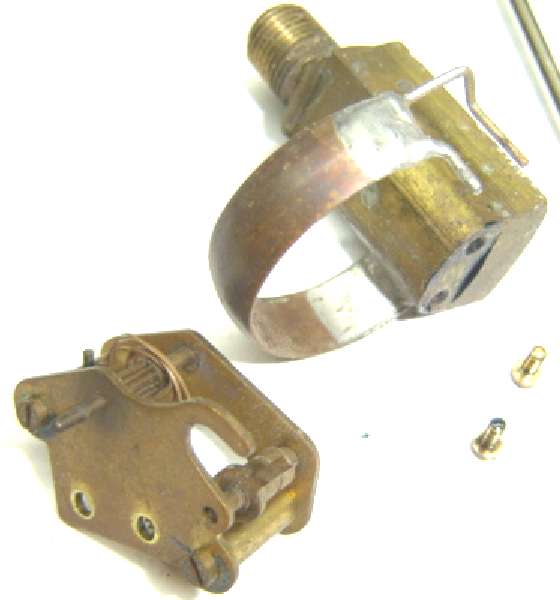The MGA With An Attitude
SAFETY GAUGE Internal Mechanism - DT-105
Function of oil pressure and water temperature gauge.
 Perquisite to this course is: DT-101,
Perquisite to this course is: DT-101,
Why doesn't my temperature gauge work?.
Read that before you start tinkering here.
Now you know if you will remove this instrument from the car you have to disconnect the temperature sensor from the engine first. Also disconnect the oil pressure tube from the back of the gauge (threaded connection). Then carefully guide the temperature sensor line through the firewall as you extract the gauge from the dash.
To open the instrument, twist the trim ring to disengage it from the case and pull forward to remove the trim ring, the glass lense, and two rubber seal rings (either side of the glass). Very carefully pull the two indicator needles off the shafts (without bending needles or shafts), then lift out the faceplate. You can then remove a pair of screws to remove a framework carrying the needle drive mechanism. You can also remove the oil pressure tube from the case. If you try to remove the temperature pressure tube from the case you would find the case is trapped on the small signal tube along with the hollow flare nut on the sensor end.

The hollow Bourdon tube of the pressure gauge is somewhat oval (nearly flat in this case), and is curled in a large arc. When the pressure inside the tube increases, the tube's oval walls are distorted and the tube's cross-section bulges out to becomes slightly more circular. The outer curve of the tube goes to larger radius as the inner curve goes to smaller radius. The walls of the tube retain nearly the original length, so the tube uncurls slightly. The amount of uncoiling that occurs is almost exactly proportional to the pressure inside the Bourdon tube. As the tube uncoils, its motion activates a rack-and-pinion gear system that turns the needle on the dial of the gauge.
As noted in the prior article, the temperature gauge actually operates by pressure of a gas inside the tube, so the mechanism is nearly identical to the parts of the oil pressure gauge. The curled pressure tube for the temperature gauge is nestled in the back part of the case, while the tube for the oil pressure gauge is positioned closer to the front. Each tube has a pair of thick wire hooks on the output end. One hook is anchored on a fixed frame. The other hook is connected to a lever arm which drives a sector gear which turns a pinion gear to rotate the output shaft.

The Bourdon tube is inherently reliable and will virtually never fail if it is not physically abused. The temperature gauge may fail if the working fluid is lost. Otherwise any problem with these units should be found in the mechanical linkages or shafts.
When reassembling this gauge, after the faceplate is replaced the needles must be installed in the correct orientation. To calibrate the oil pressure gauge, apply a known pressure (air pressure works) to the input port (50 psi is convenient), and press the needle on the shaft pointing at the specified pressure reading. To calibrate the temperature gauge, place the sensor bulb in boiling water, and press the needle on the shaft pointing to the boiling temperature (212dF or 100dC).
Thanks to Barrie Graham for the gauge internal pictures.
|